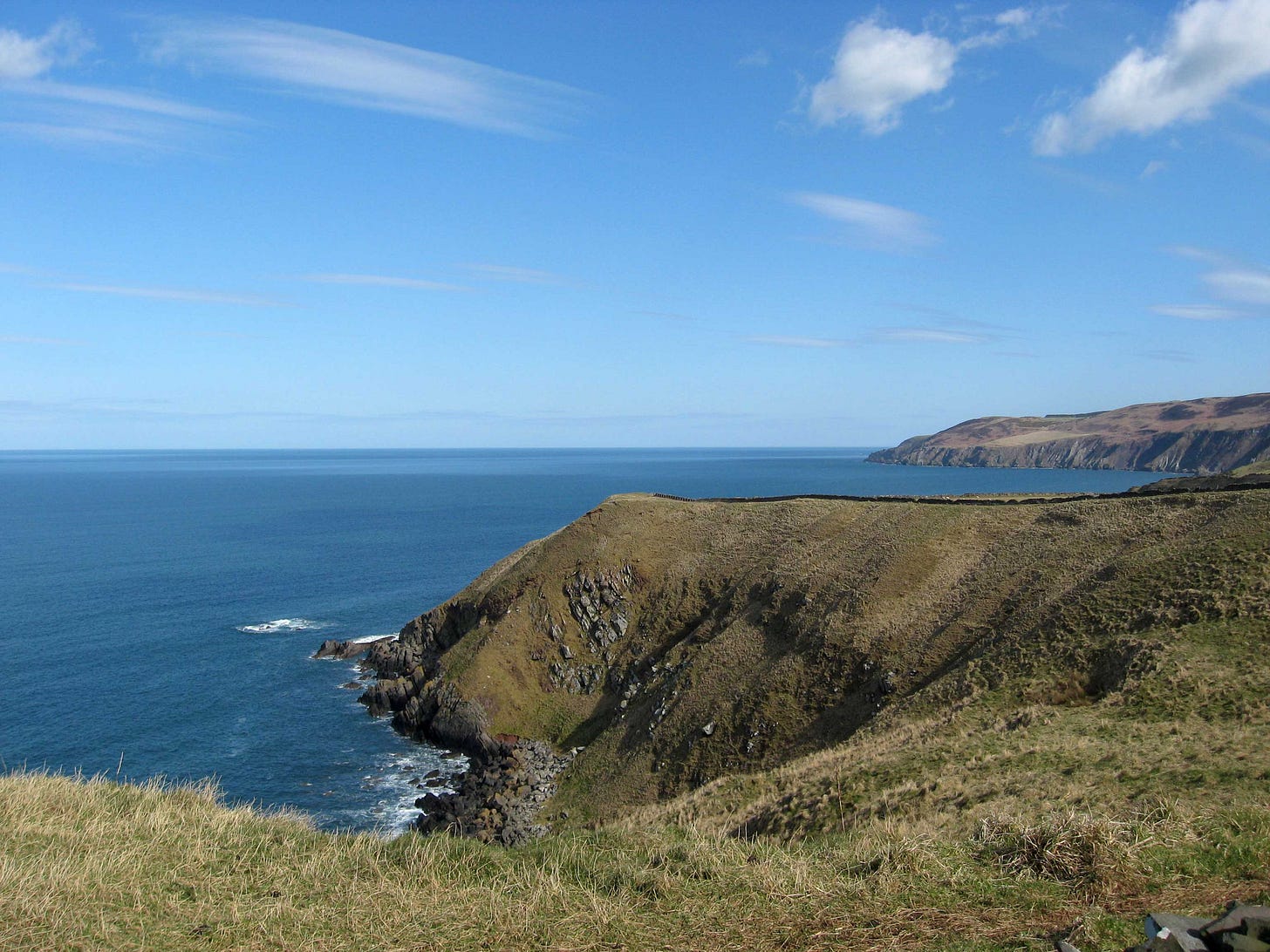Note: I am always writing as a non-expert wishing I was one. But, if I ever decided to become an expert in one particular area I would have to abandon exploring every other area of interest that crosses my path. This is not within my nature and thus cannot be done, so I proceed forward with the heart and skills of an amateur enthusiast researcher hoping to inspire. Comment below (help me) if you find any false information!
“Let us therefore open the book of Nature and read in her records”. - James Hutton, Theory of the Earth, 1785
Old Cities and the Geologic Landscape Taken for Granted (Granite?)
Everyone knows the history of Europe is very old and complex just as everyone knows the history of the Grand Canyon is very old and complex, and the visual results are beautiful. That is why so many people travel to Europe to see the medieval towns with their castles perched on a hill. Or, why they walk around Rome through the crowded streets across time with the Colosseum over here, the Trevi Fountain over there and Saint Peter’s Basilica dominating the other side of the river. It’s cool. Just like walking up to the rim of the Grand Canyon is cool. The contents of the rocky layer cake are unfathomably rich, and here, nature displays itself in all its complex splendor. The average duration of stay in Rome, London or Venice is probably about the same as a visit to the Grand Canyon or Yosemite. Two days? Maybe three? You’ve got to move on.
We have a funny relationship with complexity.
Let us call complexity in this context anything thats formation takes more time than the average human lifespan. Understanding something complex requires volunteering extended contemplation to visualize the intricate chronological processes that lead to something being the way it is currently presented. I believe along with prolonged observation, to comprehend complexity it must also be internally experienced. This takes immersion, and being presented with the same thing again and again until one thing stands out that has always been there, but is yet unnoticed. An Irregularity.

In the field of geology they call these irregularities unconformities,
when there is a break in time in an otherwise continuous rock record. Although we celebrate the Grand Canyon for its deliciously defined layers, between each of them is the confusing icing of an unconformity. These irregularities which seem meant to obliterate logic actually are the keys to piecing together all the chapters of that gaping chasm which is Earth’s epic narrative.
An irregularity stands out because it cannot be rationalized with your current all encompassing explanation. It is uncanny, but it is there in nature all the same. Recognizing this triggers one of our best natural behaviors: curiosity. Why is it there can only be found by invested looking. If you search further and longer you may begin to find that this anomaly does not stand alone. It may be a part of a pattern, and the more you look, you may find evidences everywhere which confirm its significance.
Nature is repetitive but not uniform. A desire to recognize the patterns in nature’s irregularities is quintessential to the understanding of the greater living fabric. And while discoveries of patterns bring enlightenment, they are almost never definitive conclusions. They open the door to more wonderment. Can answers to everything be found in one thing? One jumble of crisscrossing rocks, one flower in the shade, one old city street? Yes! This is the beautiful phenomenon that art and science celebrates.
Truth is often the simplest thing.
Sometimes it is so simple it is almost embarrassing to admit you did not really understand it before. At the risk of my own stupidity, I would like to recount a recent realization of a truth born out of a happenstance observation.
The following occurrence of mine is not the discovery of some Dan Brown Mary Magdalen conspiracy (I wish!), and it is magnitudes shy to the comparison I will present. Nevertheless, I will be bold and use an analogy between my young, dumb self walking around the streets of Aix-en-Provence, France in 2025 thinking “that building looks weird” and James Hutton, the father of modern geology, scouring Scotland’s rocky landscape in 1785 searching for the answer to how Earth was formed. I stumbled upon some church windows. He stumbled upon Siccar Point.
I am very fortunate to live in an immensely old European city.
A lazy description:
Aix-en-Provence is a pretty town in the south of France where two thousand years ago some Gauls were conquered by the Romans. The fight was over this unassuming sloping hillside where water sprung up in the arid landscape. Everything is made from a local yellow stone. The buildings bizarrely bulge out at the waist and chinch back tight as they grow taller, capped by terracotta tile roofs. All the window shutters are painted sky blue. It gets really windy and there are two big churches: La Cathédrale Saint-Sauveur and L'église Saint-Jean-de-Malte. Aix is Baroque in design (16th/17th century?), curvy and bedazzled, with flamboyant sculptures of gods and goddesses of grain and wine hanging from the balconies of official buildings. Funny looking fountains can be found everywhere; sometimes in tucked away streets (rues) resembling bird baths trickling out water from a mythic creature’s mouth adorned with an algae green goatee; sometimes they dominate town squares (places) with ornate spires and cascading watery tiers. Its got a little bit of architectural everything. There are medieval sections with streets windy and thin, and there are Renaissance neighborhoods (quartiers) with perfect grid layouts. There’s a bit of greenery with the iconic French sycamores (platans) systematically interspersed pushing out of the cobble stones, but most of Aix’s greenery is rudely hidden away in tranquil private courtyards. There are lots of markets, and it all fits together somehow in a sun-blasted harmony.
I’ve seen Aix and I get it.
This is the take one gets within a half-day’s tour of the city. It only takes about twenty minutes to walk from one side of the old town (centre ville) to the other. It is a pleasantly naive impression received if you don’t have the time, energy or desire to comprehend what it really is.
What is it really? In short, it is an architectural Rubik’s Cube; a time-lapse combination of intention and happenstance morphed with a logic to adapt to what was already there while improving the function for the changing cultures; maintaining aesthetic cohesion and accentuating its original character eventually arriving to its current form. It is a criteria like this which makes for towns and cities that exude life. It has filled in slowly, enriching itself like a forest ecosystem grows around a mountain stream in a freshly carved glacial valley.
But how seldomly we take notice of our surroundings!
It took me four years to arrive at my current level of appreciation of this place. How dare I not be constantly in awe living in a beautiful town in France! How shameful it was during my Wyoming stint when I saw the Grand Tetons as some personal gymnasium! Well, you try being privileged and continuously grateful. A shiny new town inevitably becomes a hometown and you’ve got big errands to run and small things to worry about.
So I was on one of these errands the other day.
It was an errand of procrastination, feeling that if I did not get a pain au chocolat (chocolate croissant) then I would not be able to focus on my work. I took an hour long stroll into the old centre-ville to the best patisserie to get one or two of my treats of inspiration (You can begin to hate me now). Deciding to procrastinate further I took the long route home to walk down my favorite street, Rue Cardinal, and skirt past my favorite bit of Aix architecture that lays at the far end, the big old church with a mighty bell tower L’eglise Saint-Jean-de-Malte. This is the ideal street to walk and eat. The French do not appreciate young people munching on the go, but you can get away with it here. In this shady urban canyon I am able to leave my trail of buttery pastry flakes without shaming glances from the elder Aixois. There’s not much traffic so you can gaze upward and ponder. You don’t need to worry too much about getting clipped by a scooter, though you may step in some crotte de chien.
This is a visually perfect street,
because it was designed with that exact intention. Rue Cardinal is in the Renaissance portion of town, Quartier Mazarin. It was built in the 17th century during the reign of Louis XIV, the Sun King, Versailles-Guy. It is comprised of a perpendicular grid of four more or less north/south streets and five more or less east/west streets. The buildings are elegant stone domiciles built for the upper class, and Rue Cardinal splits the quartier down the middle. it is a fantastic presentation of linear perspective, that thing they were so crazy about in Julius Caesar-Rome and Michaelangelo/Da Vinci-Florence. I usually adhere more to the sinewy streets of medieval times, the ones where in my fantasy an old hag could at any moment lean out a window and dump out from her wooden bucket some Camelot trash on my head.
Yet Rue Cardinal has some particular charm to it that transcends my King Arthur mindset. It is the way la Fontaine des Quatre Dauphins rests right in the middle. It is an unusual aquatic feature with a several meter tall obelisk with four limestone dolphins at its base, each with greased back hair, squirting out water into an unassuming collecting pool. Dogs on walks love to jump in for a bath and its reflection brings the light of the sky down to the street.
That visual comparison…
with the distant bell tower and the frontal facade of the church. And vanishing point perspective to a T! I have walked down this street countless times by now, I have painted it several times. Yet on this morning for some reason I felt the need to verify my confidence in the symmetrical mastery. I stood directly in the middle of the street to line it all up vertically (as it should and must), the fountain behind me and the door of the church before me. An existential wind rattled out from my soul as I stood there and realized they did not line up at all.

Askew! A visual falsehood! An anomaly! An irregularity!
What I thought I knew, I didn’t. How could these long dead master stonemasons be so careless! I had found something that would trigger that primal apple-grabbing instinct of curiosity. I had found an unconformity. This would be my Siccar Point.








